Starkon 2015 through the eyes of an indie developer
Last weekend in St. Petersburg, Starkon died - a major festival of fiction, comics, games and other entertainment.
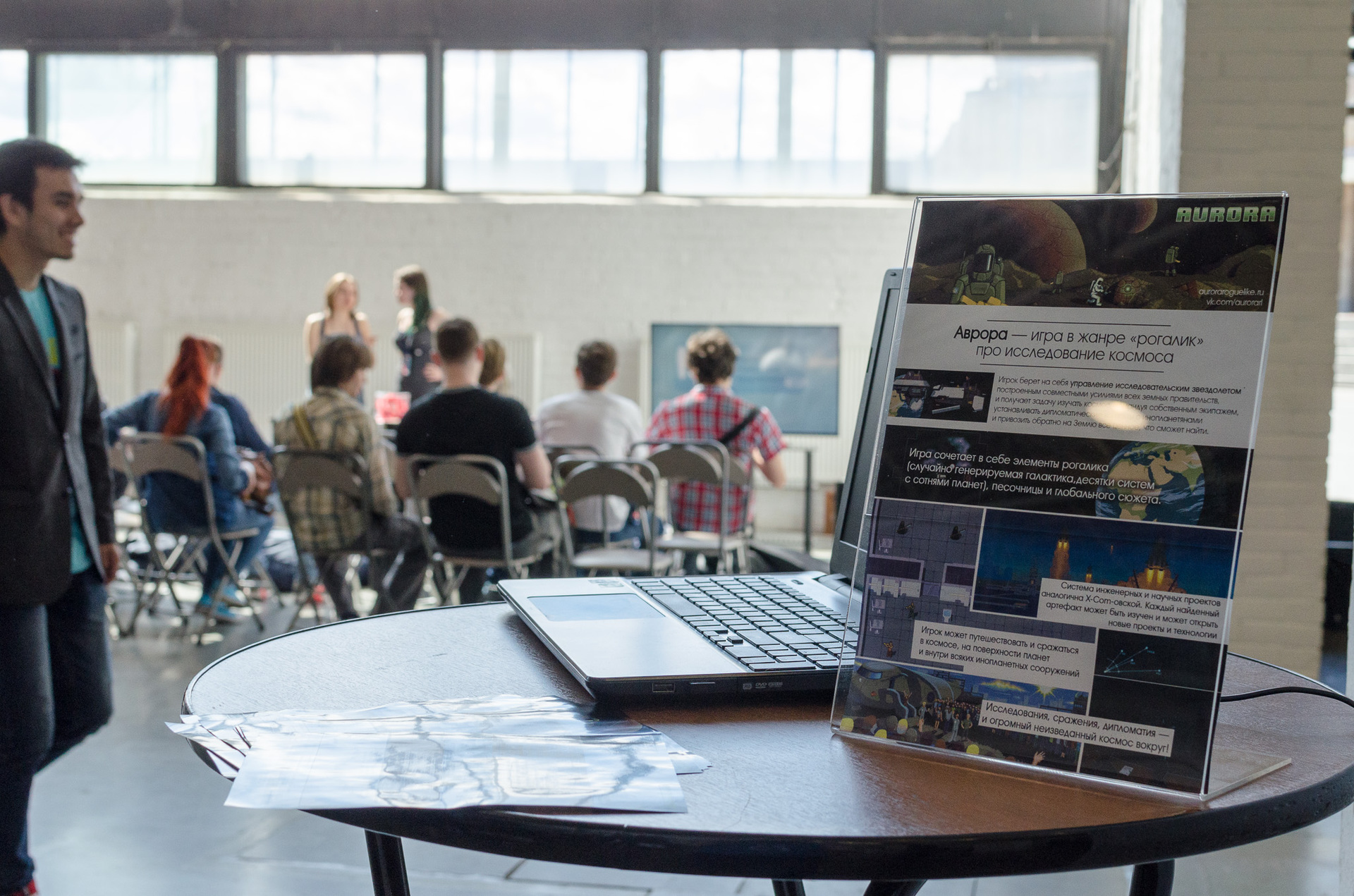
Despite the fact that many people associate it primarily with cosplayers and comics, there was also something useful for the game developer, which I want to talk about.
In addition to the assortment of souvenirs, board games, movies, comics and cosplay, which is standard for comic-like events, in one of the pavilions I found a place for myself and the Next Castle Party stand - a festival of indie and retro games regularly held in St. Petersburg. I took part in it with my Aurora RL last fall, and now, having learned that they are collecting game projects for their stand at Starkon, I hastened to sign up. To register this time, it was required to indicate the site of your project and brief information about it, provide an image for the poster and a short 10-second video (which the truth, as a result, was not shown anywhere). You do not need to be some kind of super AAA title to participate, so this is a good way for new teams to show themselves and look at others.
If NCP itself is a rather modest and lamp festival, then Starkon impressed with the scale and crowds of people. Under the NCP, a whole pavilion was allocated, which housed the traditional zones of modern and retro games, a zone for demonstrating indie games (where there was a place for our team), as well as a lecture hall where they lectured on gamedev.
The indie zone was a table, standing on the aisle, with a socket for connecting equipment, on which developers were free to demonstrate their projects on their own equipment. I took advantage of the most budget option indicated on the title photo: a laptop with a running trailer and a tablet with a description of the project. I wanted to show the game to as many potential players as possible, for which I had to fight for their attention in every possible way. From the experience of past similar events, as well as the stories of neighbors at the tables, I can say that for the demonstration it is necessary:
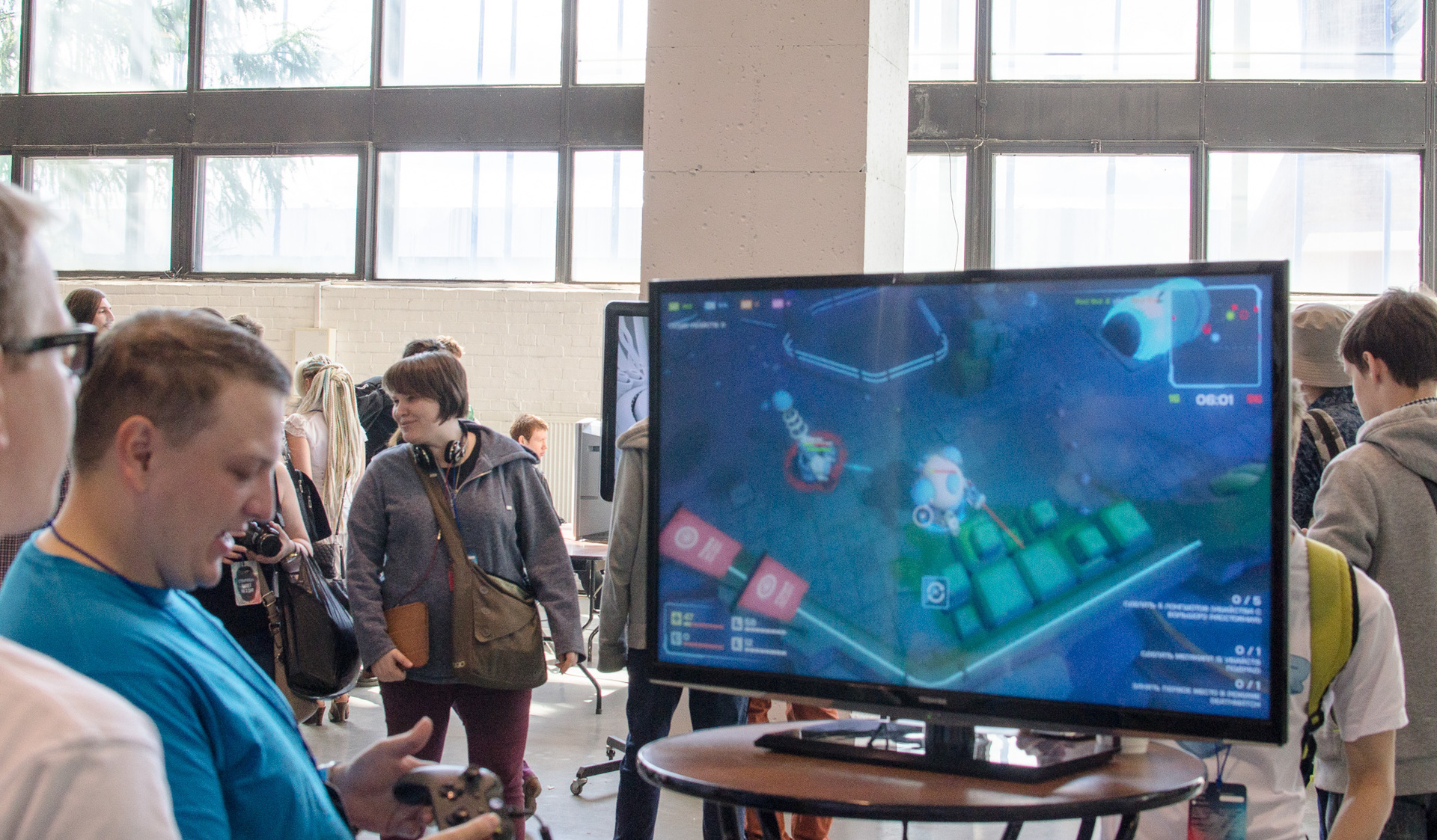
Showing on the big screen, of course, is much clearer
to some. This may seem obvious to some, but there were enough teams who did not think about this in advance and were forced to hand out to the players leaflets torn from notebooks with address or to make a tablet with the name / description of the project from the same leaflets right on the spot.
Speaking of the crowd. You need to be prepared that your equipment survives like this (find the developers there and their desks in the photo):
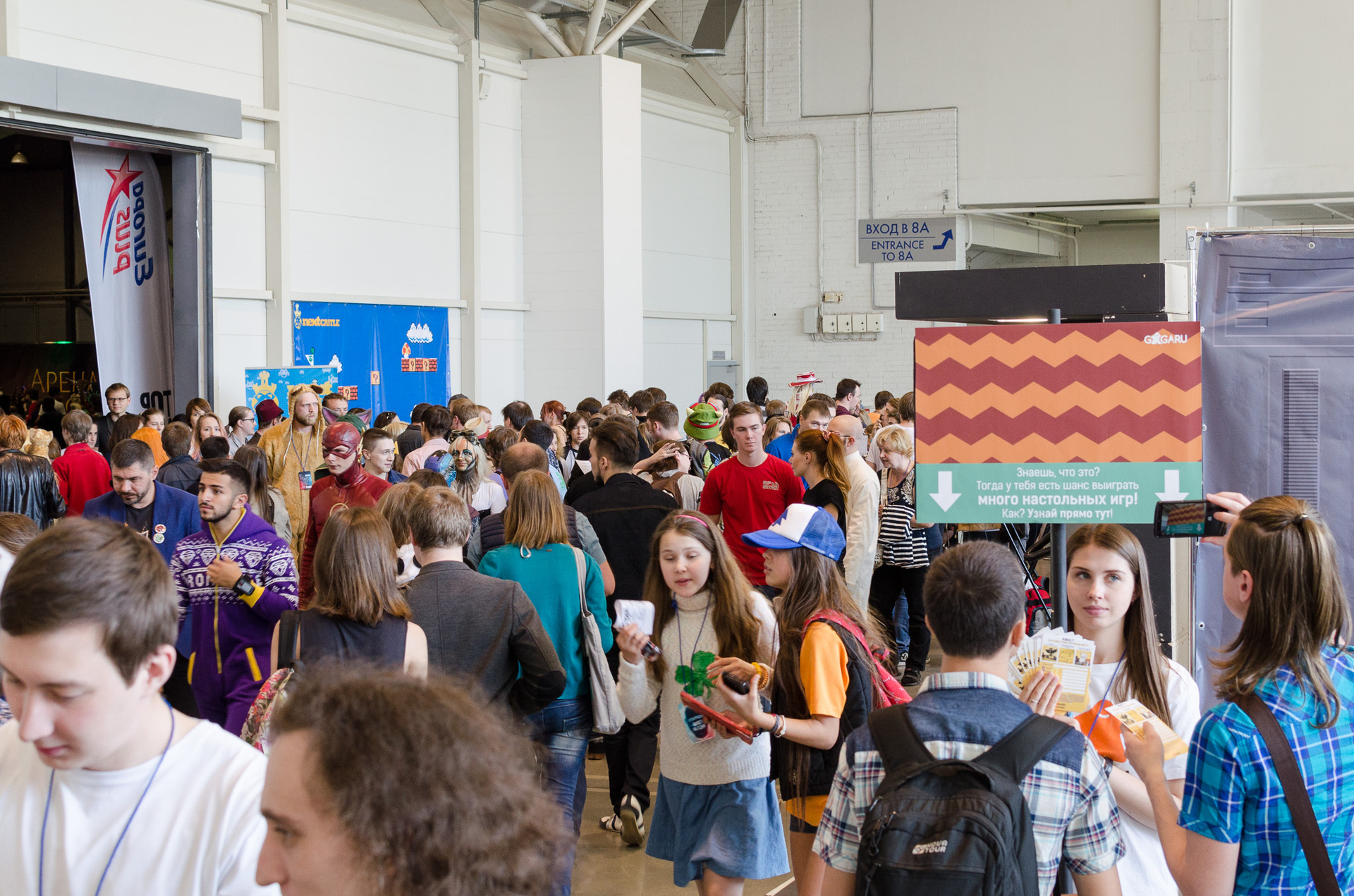
The influx of people can both help (more potential players) and hinder (people just do not have the physical ability to stay near you). It felt like Friday was the most visited day, a lot of visitors gathered for the opening, as a result, most of the developers who showed the games that day were left out of work - there simply was no place for the apple to fall, not to stop and enjoy the gameplay.
Communication with the players goes something like this: you stand at your table and shift from one foot to the other (for some reason, it is not customary to give chairs to the NCP, only a table). Periodically, one of those passing by stops and begins to peer at the screen with the trailer or read the description on the plate. Here is the time to make contact, grab by the arm and drag to play / watch along the way telling what and how is happening in your game. And do not forget to put a business card.
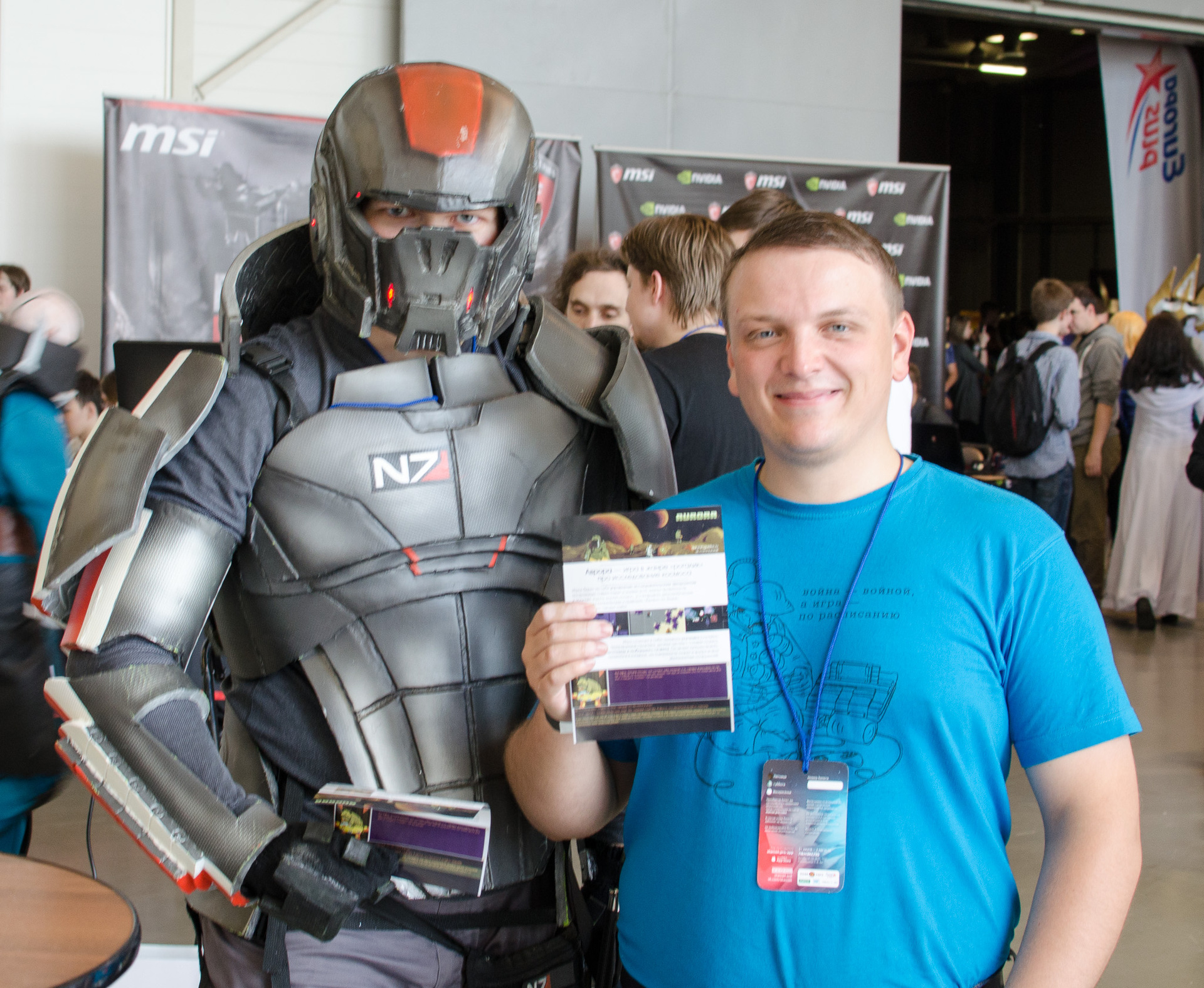
This is Commander Shepard, and this is the best game on the Citadel, hehe
The success of this whole process, of course, is largely determined by getting into the audience. According to observations, spectacular games with short sessions go well so that you can immediately give a person passing by a joystick and he immediately begins to play. In this case, you don’t even have to be near - visitors will come and try themselves from time to time. Alas, with my project, alas, slightly wrong, the bagel-like gameplay has a thoughtful and lengthy passage, so you just had to show it yourself, explaining it along the way. By the end of the day, the tongue is already slightly dry, repeating the same thing, by the way, therefore, it is advisable to have water with you (everything is wild in place, of course, but the participants are usually not inspected, so you can carry anything)
In general, somehow that's it this is what happens:

By the way, at KRI 2014, they also tried to introduce a similar format of a “business zone” with tables, for those who do not have the opportunity / desire to arrange a full-fledged stand. True, it somehow didn’t take off there, the players were not allowed there (the passage from Igromir and Komikon to the KRI zone was only for participants), and the other developers who were accidentally caught there were not interested in indie projects.
By demonstrating your game, the possibilities were not exhausted. A lecture hall was made in the corner, in which one could listen to various experts from the industry. And unlike some KRI, where last year the majority of reports were devoted to all kinds of boring things, such as how to squeeze more money out of a user, NCP usually discusses rather practical things about art, game design and programming. Unfortunately, this time the lecture hall was not well located, there was no separate room for it, so the shots, explosions and music rushing from everywhere greatly interfered with listening. But judging by the fact that there was always almost full of knowledge-hungry, this did not distract.
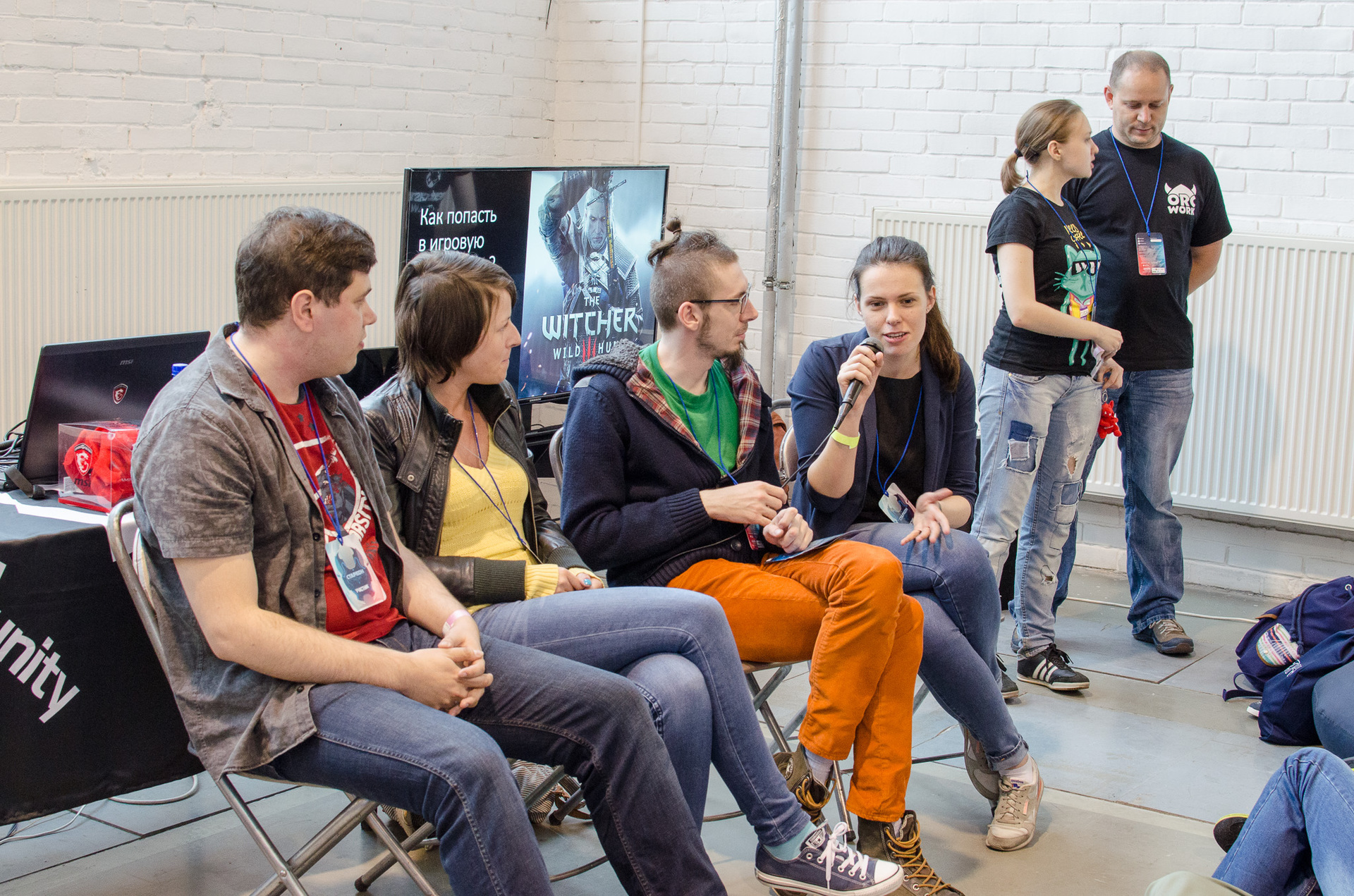
Developers talk about how you can get into the industry
From a corner of my ear I can note a lecture on the artistic style of the characters (although I myself am a programmer, I have to delve into everything in a small team or not), as well as about accidents in game design, maybe some of the ideas outlined there (for example, a curious version of refusal from chance, when instead of an honest randomness, pre-generated sequences of numbers are used to avoid albeit unlikely, but possible situations such as ten misses in a row) I will use in my game.
About efficiency
I must say right away that the effectiveness of such events, expressed in numbers, is rather modest. For one day of participation, several dozen people approached us (I handed out about half of the printed pack to 100 leaflets somewhere), while the number of game installations grew by only three dozen, plus a couple of subscribers in the group. In part, this can be explained by the insufficient compliance of the project with the audience, since everything was much more fun on the same NCP, at least in terms of the number of people who were interested (I didn’t think of downloading statistics then) and their relevance to our project (for example, almost everyone there knows Star Control 2, from which I drew inspiration, while on StarCon the majority knew the most about Space Rangers).
The main plus of participation is, of course, communication. With other developers who can come up with interesting ideas, with players (because here you can get live feedback right on the spot, a kind of corridor testing, for which indie teams often do not have the resources), with various game players and other representatives of the game ograzh, who can to help spread your project.
Well, to look at pretty cosplayers for free (the participants do not pay for the entrance, of course), it is also always nice, where without it.
So if you are an indie developer with your own playable project, I can recommend you to take part! The next Next Castle Party will be held in the fall in St. Petersburg, registration for developers will open sometime in August at http://2015.nextcastle.ru/ru/ .
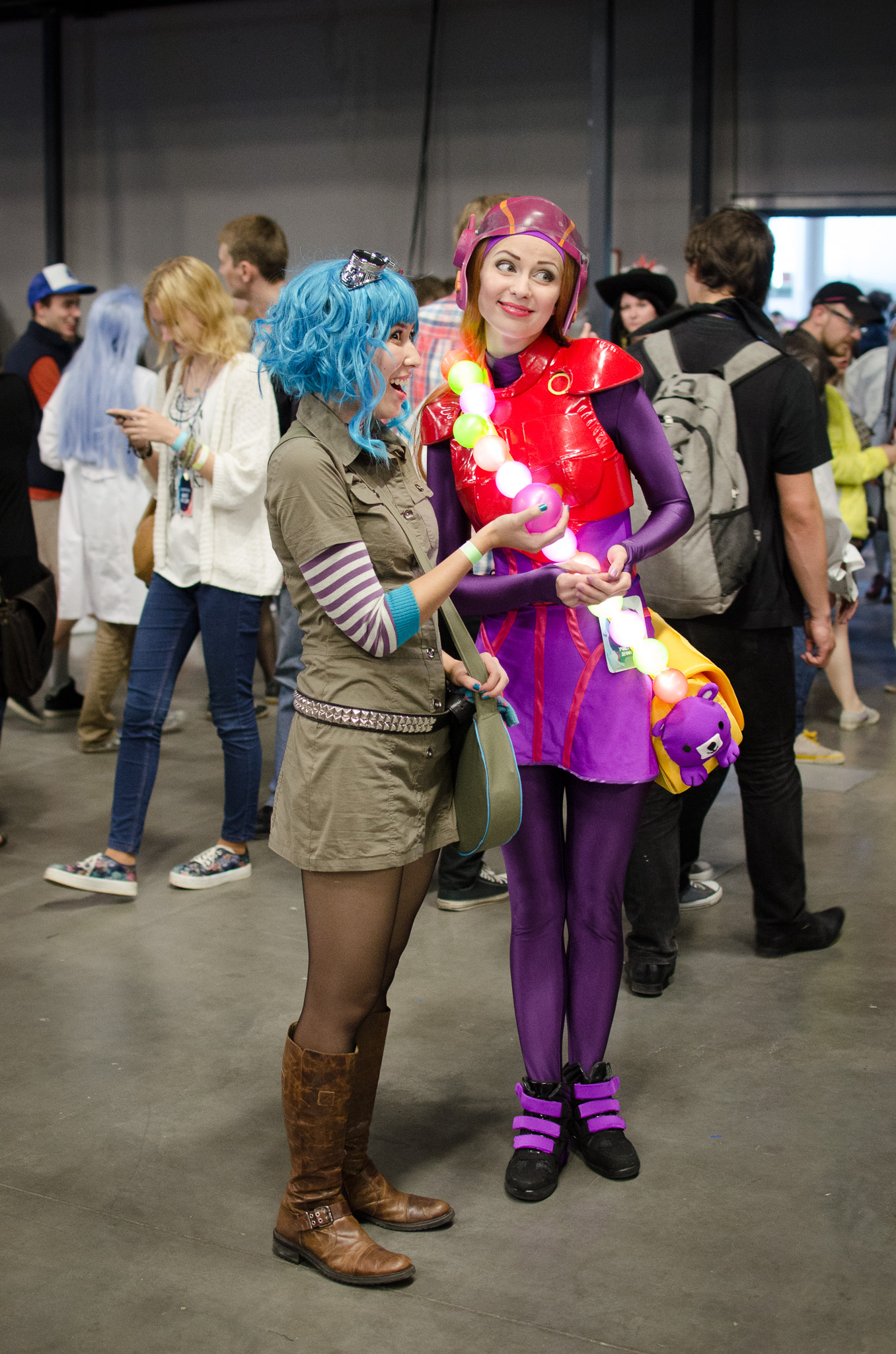

Despite the fact that many people associate it primarily with cosplayers and comics, there was also something useful for the game developer, which I want to talk about.
In addition to the assortment of souvenirs, board games, movies, comics and cosplay, which is standard for comic-like events, in one of the pavilions I found a place for myself and the Next Castle Party stand - a festival of indie and retro games regularly held in St. Petersburg. I took part in it with my Aurora RL last fall, and now, having learned that they are collecting game projects for their stand at Starkon, I hastened to sign up. To register this time, it was required to indicate the site of your project and brief information about it, provide an image for the poster and a short 10-second video (which the truth, as a result, was not shown anywhere). You do not need to be some kind of super AAA title to participate, so this is a good way for new teams to show themselves and look at others.
If NCP itself is a rather modest and lamp festival, then Starkon impressed with the scale and crowds of people. Under the NCP, a whole pavilion was allocated, which housed the traditional zones of modern and retro games, a zone for demonstrating indie games (where there was a place for our team), as well as a lecture hall where they lectured on gamedev.
The indie zone was a table, standing on the aisle, with a socket for connecting equipment, on which developers were free to demonstrate their projects on their own equipment. I took advantage of the most budget option indicated on the title photo: a laptop with a running trailer and a tablet with a description of the project. I wanted to show the game to as many potential players as possible, for which I had to fight for their attention in every possible way. From the experience of past similar events, as well as the stories of neighbors at the tables, I can say that for the demonstration it is necessary:
- Gameplay video / trailer. Usually, everything is shown on laptops, the preferred option is a large screen. You can also connect a tablet to it if the game is for mobile devices (tablets / smartphones in the crowd are difficult to see). If your game is for mobile OS, then do not forget to take more devices (at least 3 pieces), where visitors can play. At first, it’s a little scary to leave a bunch of equipment in the middle of an unfamiliar crowd, but so far it seems that nothing has been stolen or broken from anyone.
- A tablet from which it will immediately become clear what is generally there. Many visitors have a vague idea of what is happening (especially at large festivals of a general orientation) - some people, some laptops. At the same time, not everyone is ready to ask a person who is leaning close (and it’s impossible to stay there all the time, especially if there are no helpers), if they are not interested in a couple of seconds, they will pass by to that busty cosplayer.
Regarding the format - there are options. I used the simplest - an A4 sheet inserted into the holder. Some of the teams made banners about the size of a person. On the one hand, this, of course, attracts attention better, on the other hand, it costs money and takes a place that is very small in the crowd, as a result, some spoke of these banners as worthless expenses. - Handouts. Okay, here a man came up, listened to your story, seemed to be interested and wants to play at his own leisure. Where can he get your game? At past events, I handed out business cards, but I often fell into the situation when after a conference you hold a bunch of these same business cards in your hands and you can’t remember which one is who and who are all these people. So this time I decided to try to make more informative flyers containing a brief description of the game, screenshots and all the necessary links. Printing hundreds of color A5 double-sided leaflets on glossy paper cost me a couple of thousand, hundreds are usually enough with my head for a couple of days of the event.

Showing on the big screen, of course, is much clearer
to some. This may seem obvious to some, but there were enough teams who did not think about this in advance and were forced to hand out to the players leaflets torn from notebooks with address or to make a tablet with the name / description of the project from the same leaflets right on the spot.
Speaking of the crowd. You need to be prepared that your equipment survives like this (find the developers there and their desks in the photo):

The influx of people can both help (more potential players) and hinder (people just do not have the physical ability to stay near you). It felt like Friday was the most visited day, a lot of visitors gathered for the opening, as a result, most of the developers who showed the games that day were left out of work - there simply was no place for the apple to fall, not to stop and enjoy the gameplay.
Communication with the players goes something like this: you stand at your table and shift from one foot to the other (for some reason, it is not customary to give chairs to the NCP, only a table). Periodically, one of those passing by stops and begins to peer at the screen with the trailer or read the description on the plate. Here is the time to make contact, grab by the arm and drag to play / watch along the way telling what and how is happening in your game. And do not forget to put a business card.

This is Commander Shepard, and this is the best game on the Citadel, hehe
The success of this whole process, of course, is largely determined by getting into the audience. According to observations, spectacular games with short sessions go well so that you can immediately give a person passing by a joystick and he immediately begins to play. In this case, you don’t even have to be near - visitors will come and try themselves from time to time. Alas, with my project, alas, slightly wrong, the bagel-like gameplay has a thoughtful and lengthy passage, so you just had to show it yourself, explaining it along the way. By the end of the day, the tongue is already slightly dry, repeating the same thing, by the way, therefore, it is advisable to have water with you (everything is wild in place, of course, but the participants are usually not inspected, so you can carry anything)
In general, somehow that's it this is what happens:

By the way, at KRI 2014, they also tried to introduce a similar format of a “business zone” with tables, for those who do not have the opportunity / desire to arrange a full-fledged stand. True, it somehow didn’t take off there, the players were not allowed there (the passage from Igromir and Komikon to the KRI zone was only for participants), and the other developers who were accidentally caught there were not interested in indie projects.
By demonstrating your game, the possibilities were not exhausted. A lecture hall was made in the corner, in which one could listen to various experts from the industry. And unlike some KRI, where last year the majority of reports were devoted to all kinds of boring things, such as how to squeeze more money out of a user, NCP usually discusses rather practical things about art, game design and programming. Unfortunately, this time the lecture hall was not well located, there was no separate room for it, so the shots, explosions and music rushing from everywhere greatly interfered with listening. But judging by the fact that there was always almost full of knowledge-hungry, this did not distract.

Developers talk about how you can get into the industry
From a corner of my ear I can note a lecture on the artistic style of the characters (although I myself am a programmer, I have to delve into everything in a small team or not), as well as about accidents in game design, maybe some of the ideas outlined there (for example, a curious version of refusal from chance, when instead of an honest randomness, pre-generated sequences of numbers are used to avoid albeit unlikely, but possible situations such as ten misses in a row) I will use in my game.
About efficiency
I must say right away that the effectiveness of such events, expressed in numbers, is rather modest. For one day of participation, several dozen people approached us (I handed out about half of the printed pack to 100 leaflets somewhere), while the number of game installations grew by only three dozen, plus a couple of subscribers in the group. In part, this can be explained by the insufficient compliance of the project with the audience, since everything was much more fun on the same NCP, at least in terms of the number of people who were interested (I didn’t think of downloading statistics then) and their relevance to our project (for example, almost everyone there knows Star Control 2, from which I drew inspiration, while on StarCon the majority knew the most about Space Rangers).
The main plus of participation is, of course, communication. With other developers who can come up with interesting ideas, with players (because here you can get live feedback right on the spot, a kind of corridor testing, for which indie teams often do not have the resources), with various game players and other representatives of the game ograzh, who can to help spread your project.
Well, to look at pretty cosplayers for free (the participants do not pay for the entrance, of course), it is also always nice, where without it.
So if you are an indie developer with your own playable project, I can recommend you to take part! The next Next Castle Party will be held in the fall in St. Petersburg, registration for developers will open sometime in August at http://2015.nextcastle.ru/ru/ .

